The short route
Why bouncers are a welcome change in a batsman-dominated game
29-Oct-2006
|
|

|
A few teams have decided to take the short route to the Champions Trophy semi-finals. First it was South Africa pitching short to bounce one of the favoured teams in Sri Lanka out of the tournament. This was a well-planned strategy to negate the effect of the dew and South Africa didn't utilise even one over of spin in their comprehensive victory over a rattled Sri Lanka. In doing so they took the first step to a semi-final.
Having seen the tactic work so well in Ahmedabad, New Zealand then implemented a similar strategy on the bouncier Mohali pitch. The Kiwis even took the precaution of omitting their successful spinner Jeetan Patel so they could include an extra fast bowler in case they had to bowl second. The plan worked a treat and New Zealand's thoughtful victory made them the first team to qualify for the semi-finals.
Expect Australia to adopt a similar approach in their do-or-die encounter with India at Mohali. Australia signalled their intentions in Jaipur when they left Brad Hogg out of the team in order to include an extra pace option in Mitchell Johnson. The Australians will be delighted when they see the Mohali pitch; it has quite a healthy coverage of grass and affords more bounce than most Indian pitches. Bowling first or last, this pitch suits Australia more than India.
In fact this tournament hasn't been kind to the spinners in the usual hospitable Indian way. Only four appear in the top 22 wicket-takers and two of them are Sri Lankans who are now back home.
Considering the success already gained from the liberal use of the short-pitched delivery it may be assumed every team will adopt similar tactics. However, a "one size fits all" approach is no guarantee of success. Against New Zealand Abdul Razzaq often pitched short in his final overs and the flood of runs that ensued probably cost Pakistan any chance of victory.
|
|

|
Regular use of the short-pitched delivery will serve teams like South Africa, New Zealand and Australia well but I'm not sure about the others. It seems daft to say that it definitely won't suit West Indies when they used to be the kings of pace and unerringly accurate short-pitched deliveries, but this is a far different attack from the one of the seventies and eighties. And I doubt it will be employed by India; if they do it's likely to be a failure.
There is one other thing to be considered about the tactic of pitching short; the opposition. It is not advisable to bowl short to the Australian top order regularly; they are used to bouncier pitches and play the horizontal bat shots better than any other team. A barrage of short-pitched deliveries might just be the thing Ricky Ponting needs to find his best form.
The other important question regarding this tactical development that requires an answer is; "Will it work in the final?"
Pitching short may well be a good tactic at Mohali and to a lesser extent at Jaipur but it wouldn't be wise to adopt it on the slower less bouncy Brabourne stadium pitch. In Mumbai the slowness and uncertain bounce of the pitch means it is smarter to have batsmen driving rather than playing off the back foot.
The most interesting thing about this tournament has been the development of tactics to overcome the inconsistent pitches and dew factor. Cricket is at its best when it develops into a tactical battle and this really only happens when the balance between bat and ball is fairly even. Tactical battles can't be induced artificially by drafting super-sub and Powerplay laws.
The sight of the ball bouncing chest high and batsmen scampering hard-earned runs on the spacious Mohali outfield is a pleasant change after too many one-sided batting exhibitions in one-day cricket. It may not suit India as they try to qualify in what will be a difficult contest against Australia but it is a far better direction for the game to take than the one it has been following recently.